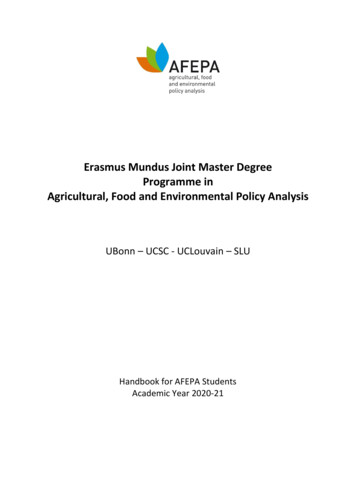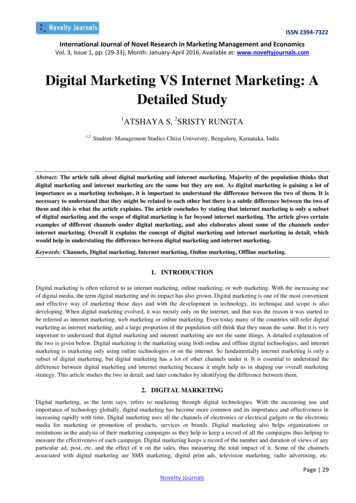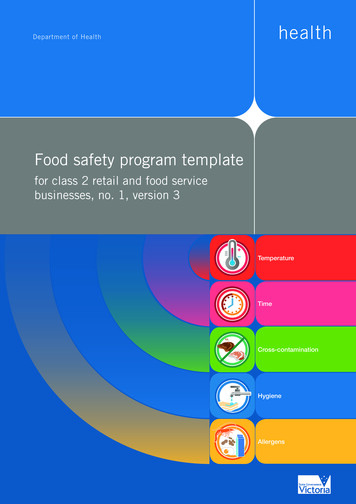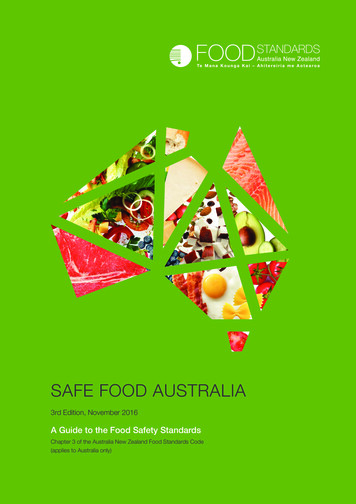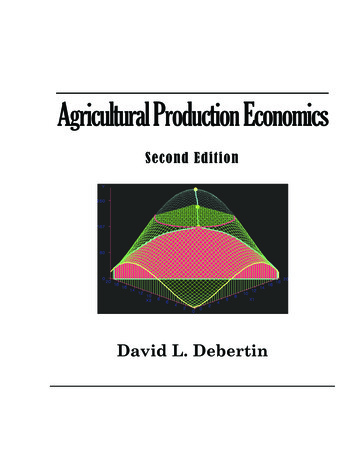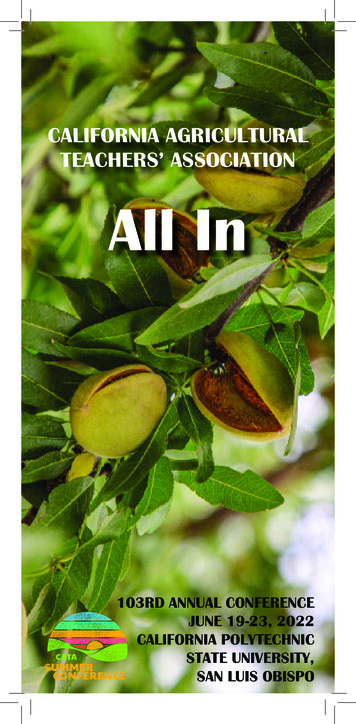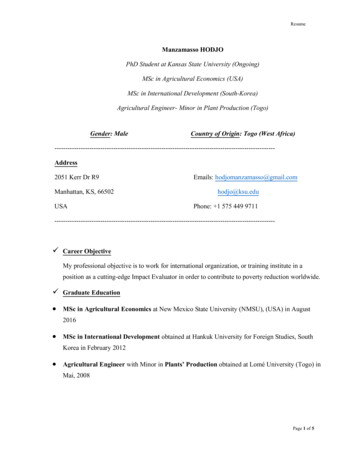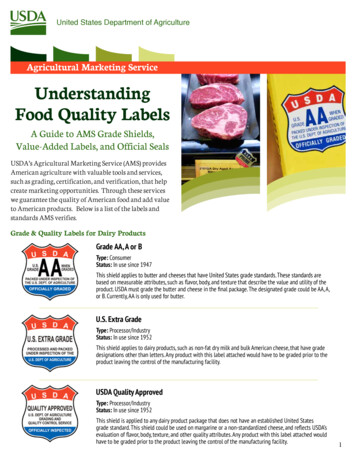
Transcription
United States Department of AgricultureAgricultural Marketing ServiceUnderstandingFood Quality LabelsA Guide to AMS Grade Shields,Value-Added Labels, and Official SealsUSDA’s Agricultural Marketing Service (AMS) providesAmerican agriculture with valuable tools and services,such as grading, certification, and verification, that helpcreate marketing opportunities. Through these serviceswe guarantee the quality of American food and add valueto American products. Below is a list of the labels andstandards AMS verifies.Grade & Quality Labels for Dairy ProductsGrade AA, A or BType: ConsumerStatus: In use since 1947This shield applies to butter and cheeses that have United States grade standards. These standards arebased on measurable attributes, such as flavor, body, and texture that describe the value and utility of theproduct. USDA must grade the butter and cheese in the final package. The designated grade could be AA, A,or B. Currently, AA is only used for butter.U.S. Extra GradeType: Processor/IndustryStatus: In use since 1952This shield applies to dairy products, such as non-fat dry milk and bulk American cheese, that have gradedesignations other than letters. Any product with this label attached would have to be graded prior to theproduct leaving the control of the manufacturing facility.USDA Quality ApprovedType: Processor/IndustryStatus: In use since 1952This shield is applied to any dairy product package that does not have an established United Statesgrade standard. This shield could be used on margarine or a non-standardized cheese, and reflects USDA’sevaluation of flavor, body, texture, and other quality attributes. Any product with this label attached wouldhave to be graded prior to the product leaving the control of the manufacturing facility.1
Agricultural Marketing ServiceUnderstanding Food Quality LabelsGrade & Quality Labels for Fruits, Vegetables, and Specialty CropsContinuous Inspection GradesType: Packer/IndustryStatus: In use since 1973The Continuous Inspection Grades and Inspection Marks are for useby plants operating under USDA continuous inspection contracts forprocessed fruits and vegetables. The grade mark would indicate thequality level of the product. The designated grade could be Grade A(shown left) or Grade B (shown right).Continuous Inspection MarksType: Packer/IndustryStatus: In use since 1956The Continuous Inspection Marks are for use by plants operating underUSDA continuous inspection contracts. No grade is designated, and thestatement may be used inside a shield (shown left) or without the useof an emblem or shield (shown right).Inspection GradesType: Packer/IndustryStatus: In use since 1956Inspection Grades are for use by plants operating under USDA inspectionservice contracts. The grade mark indicates the quality level of the product.The Grade A shield is typically tri-colored in blue, white, and red from topto bottom.Inspection MarksType: Packer/IndustryStatus: In use since 1956Inspection Marks are for use by plants operating under USDA inspectionservice contracts. They are used without a grade, and can be used with theshield (shown left) and without the shield (shown right).Quality Assurance Program (QAP)Type: Packer/IndustryStatus: In use since 1976The Quality Assurance Program (QAP) shield is used to designateparticipation in the QAP service. The facility under contract is operatedwith USDA oversight, their quality control program is reliable, and capableof producing sound and wholesome product of the desired quality undersanitary conditions.2
Agricultural Marketing ServiceUnderstanding Food Quality LabelsGrade & Quality Labels for Fruits, Vegetables, and Specialty Crops (continued)Processed Product Inspection MarksType: Processor/IndustryStatus: In use since 1983This inspection mark is for processed products produced in an approvedplant and inspected and certified by an inspector on a lot basis. They areused without a grade, and can be used with the shield (shown left) andwithout the shield (shown right).Processed Product Grade MarksType: Processor/IndustryStatus: In use since 1956Inspection Grade and Inspection marks indicate the processed fruits and vegetable products have beenproduced in an approved plant and inspected and certified by an inspector on a lot basis. The grade markindicates the quality level of the product. Grades are typically Grade A, B, or C.Sampling MarksJUNE 22, 2017Type: Processor/IndustryStatus: In use since 1955Official sampling marks identify products that have been officially sampled by a particular field officeindicated by a code mark identifying the field office performing the sampling.42Graded Product Packed Under Continuous InspectionType: Packer/IndustryStatus: In use since 1956The approved shield with the appropriate U.S. grade designation may be used on containers, labels, orother packaging. Usage is when the product is packed under continuous inspection by the USDA inspectionservice, the plant in which the product is packed is maintained under good commercial sanitary practicesand the product has been certified by an inspector as meeting the requirements of the U.S. Grade A, GradeNo. 1 or a higher designated grade.Continuous Inspection by Federal-State Licensed EmployeesType: Packer/IndustryStatus: In use since 1956A federal-state licensed employee uses the following shields in facilitiespacking under continuous inspection, and the product meets a U.S. Gradeof No. 1. Two examples of shields with packer identification numbers areprovided here.PACKER NO. 01PACKED UNDER CONTINUOUSFEDERAL-STATE INSPECTION3
Agricultural Marketing ServiceUnderstanding Food Quality LabelsGrade & Quality Labels for Fruits, Vegetables, and Specialty Crops (continued)Fresh Produce Inspected LotsJUNE 22, 2017545Type: Packer/IndustryStatus: In use since 1956Fresh produce that is inspected on a lot-by-lot basis is identified by the official inspection mark. The mark isstamped on a container.Qualified Through Verification (QTV)Type: Consumer/IndustryStatus: In use since 1997The Qualified Through Verification (QTV) shield is used to designate participation in the QTV program. TheQTV program is a food safety based program with a foundation of Hazard Analysis Critical Control Point(HACCP) principles, Good Manufacturing Practices (GMP’s), AMS’s “Good Agricultural Practices” and “GoodHandling Practices” (GAP and GHP) Verification, effective sanitation programs, product recall planning, andmicrobiological testing.Quality Monitoring Program (QMP)Type: ConsumerStatus: In use since 2007The Quality Monitoring Program (QMP) logo is used to designate participation in the QMP. QMP provides asupplier with an objective, third party assessment of the product’s quality. These evaluations may be basedon official U.S. grade standards or customer quality specifications.Partners in Quality (PIQ)Type: Packer/Processor/IndustryStatus: In use since 1997The Partners in Quality (PIQ) shield designates a client’s participation in programs that USDA licensedpersonnel audit. Auditors document intensive systems used by packinghouses to ensure the quality of thecommodities passing through them.Identity Preservation (IP)Type: Processor/IndustryStatus: In use since 2008The Identity Preservation (IP) Program logo is used by clients that are enrolled in the IP Program. It is usedto verify client claims about certain unique values of a product.Good Agricultural Practices (GAP) and Good Handling Practices (GHP)Type: Packer/Processor/IndustryStatus: In use since 2007This logo is used to designate participation in Specialty Crop Good Agricultural Practices (GAPs) and GoodHandling Practices (GHP) audit programs.4
Agricultural Marketing ServiceUnderstanding Food Quality LabelsUSDA Certified OrganicOrganic SealType: Consumer/Processor/IndustryStatus: In use since 2002Organic certification verifies that farms and businesses comply with the USDA organic regulations and allowsbusinesses to sell, label, and represent their products as organic. There are three distinct labeling categoriesfor organic products: 100 Percent Organic - Agricultural products in the “100 percent organic” category contain onlyingredients that are certified organic, including any processing aids. Organic - Agricultural products in the “organic” category must contain no less than 95 percent ofcertified organic ingredients (excluding salt and water). The remaining five percent of ingredientsmust be organically produced, unless commercially unavailable or allowed on the National List. “Made With” Organic - Multi-ingredient agricultural products in the “made with” category contain atleast 70 percent certified organic ingredients (excluding salt and water). Any remaining agriculturalproducts are not required to be organically produced, but must be produced without excludedmethods – for example, genetic engineering.Grades for PoultryGrade ShieldType: ConsumerStatus: In use since 1976USDA poultry grading is a voluntary service paid for by poultry producers. As an independent third party,USDA is recognized for assuring that poultry meet the U.S. grade standards. While there are other grades,Grade A is the most common grade sold in supermarkets. What makes poultry products qualify for GradeA depends on the absence of “defects,” such as the presence of feathers or bruising and discoloration. Aspoultry is graded, it either meets Grade A criteria for quality or it is downgraded to lesser grades (B &C)depending on the number of defects.Grades for EggsShell Egg GradesType: ConsumerStatus: In use since 1963USDA shell egg grading is a voluntary service paid for by shell egg producers. As an independent thirdparty, USDA is recognized for assuring that eggs meet the U.S. grade standards for quality and sanitaryprocessing. Eggs are categorized into one of three consumer grades: Grade AA – The freshest and highest quality eggs will receive a Grade AA. Grade A – Very high quality eggs will receive a Grade A. Grade B – Grade B eggs are usually used for breaking stock (liquid eggs) and baking, depending onthe number of defects.5
Agricultural Marketing ServiceUnderstanding Food Quality LabelsGrade & Quality Labels for BeefBeef GradesType: ConsumerStatus: In use since 1927The USDA grade shields are highly regarded as symbols of high-quality American beef. Quality grades arewidely used as a “language” within the beef industry, making business transactions easier and providing avital link to support rural America. Beef grades include: Prime – Prime beef is produced from young, well-fed beef cattle. It has abundant marbling (theamount of fat interspersed with lean meat), and is generally sold in restaurants and hotels. Choice – Choice beef is high quality, but has less marbling than Prime. Select – Select beef is very uniform in quality and normally leaner than the higher grades. It is fairlytender, but because it has less marbling, it may lack some of the juiciness and flavor of the highergrades. Standard and Commercial – Standard and Commercial grades of beef are frequently sold asungraded or as store brand meat. Utility, Cutter, and Canner grades of beef are seldom, if ever, sold atretail. Instead they are used to make ground beef and processed products.Tender & Very Tender ShieldsType: ConsumerStatus: In use since 2012USDA Certified Tender or Very Tender is a marketing program that aids consumersin making decisions on which beef cuts to purchase, and allows beef processorsto market products as USDA Certified Tender or Very Tender. In order to becomequalified to carry the Tender or Very Tender label, wholesalers or retailers are required to have certain beefmuscles pass a slice shear force test that determines the tenderness of the muscle and associated muscles.Process Control Certification ProgramType: IndustryStatus: In use since 2001This program is intended to add value to processed, donated red meat commodities through audit basedprocess control. One AMS agent per shift will be required to monitor the PCCP operations of the entireproduction facility. The PCCP emblem may be used in advertising and promotional literature for finishedgoods distributed to States or State school systems, as well as commercial products produced with AMSVerification.Additional Quality Labels for Livestock, Egg, and PoultryProcess Verified ProgramType: Consumer/IndustryStatus: In use since 2005Built upon the ISO 9001 Quality Management Systems Standard, Process Verified Programs (PVP) involve acomprehensive quality management system review, which allow companies to market their products usingthe USDA PVP shield. The PVP allows companies to develop their own marketing claims, such as a feedingclaim, or use an established standard such as Never Ever 3 (never ever given hormones, antibiotics, or animalbyproducts).6
Agricultural Marketing ServiceUnderstanding Food Quality LabelsAdditional Quality Labels for Livestock, Egg, and PoultryAccepted as SpecifiedType: IndustryStatus: In use since the 1960sUnder the certification service, meat, poultry and egg products are officially accepted as specified by AMSemployees according to detailed specification requirements. These services ensure that volume buyersreceive products that meet their specifications and comply with contractual requirements. These servicesalso fill various market niches requiring export certification or various foreign country requirements.Plant Variety ProtectionPVP SealType: Industry/AcademiaStatus: In use since 1970Used only on Plant Variety Protection certificates which are issued by USDA. Similar to a patent, but verifiesplant varieties.7
Inspection Marks are for use by plants operating under USDA inspection service contracts. They are used without a grade, and can be used with the shield (shown left) and without the shield (shown right). Quality Assurance Program (QAP) Type: Packer/Industry Status: In use since 1976 The Quality Assurance Program (QAP) shield is used to designate





